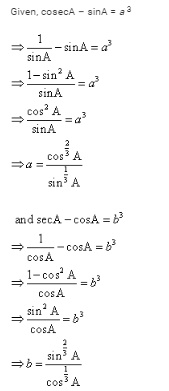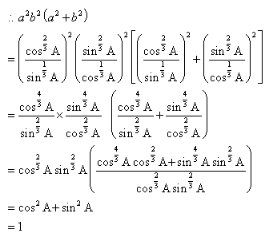Class 10 Exam > Class 10 Questions > If cosec theta - sin theta =a cube , sec thet...
Start Learning for Free
If cosec theta - sin theta =a cube , sec theta - cos theta= b cube , then prove that a square×b square (a square b square)=1?
Verified Answer
If cosec theta - sin theta =a cube , sec theta - cos theta= b cube , t...


 This question is part of UPSC exam. View all Class 10 courses
This question is part of UPSC exam. View all Class 10 courses
Most Upvoted Answer
If cosec theta - sin theta =a cube , sec theta - cos theta= b cube , t...
Proof:
Given: cosec(theta) - sin(theta) = a^3 ...(1)
sec(theta) - cos(theta) = b^3 ...(2)
To prove: a^2 * b^2 = 1
Proof of a^2 * b^2 = 1:
We can start by manipulating equations (1) and (2) to eliminate trigonometric functions and simplify the expressions.
From equation (1), we can rewrite it as:
cosec(theta) = sin(theta) + a^3 ...(3)
Similarly, from equation (2), we can rewrite it as:
sec(theta) = cos(theta) + b^3 ...(4)
Now, we can square both sides of equations (3) and (4) to eliminate the square root and simplify the expressions:
(cosec(theta))^2 = (sin(theta) + a^3)^2 ...(5)
(sec(theta))^2 = (cos(theta) + b^3)^2 ...(6)
Using the trigonometric identity for square of cosec(theta) and sec(theta):
(cosec(theta))^2 = 1 + (cot(theta))^2 ...(7)
(sec(theta))^2 = 1 + (tan(theta))^2 ...(8)
Substituting equations (7) and (8) into equations (5) and (6), we get:
1 + (cot(theta))^2 = (sin(theta) + a^3)^2 ...(9)
1 + (tan(theta))^2 = (cos(theta) + b^3)^2 ...(10)
Expanding the square terms on the right-hand side of equations (9) and (10), we have:
1 + (cot(theta))^2 = sin^2(theta) + 2a^3sin(theta) + a^6 ...(11)
1 + (tan(theta))^2 = cos^2(theta) + 2b^3cos(theta) + b^6 ...(12)
Now, we can use the trigonometric identity for cot(theta) and tan(theta):
cot(theta) = 1/tan(theta) ...(13)
Substituting equation (13) into equation (11), we get:
1 + (1/(tan(theta)))^2 = sin^2(theta) + 2a^3sin(theta) + a^6 ...(14)
Similarly, substituting equation (13) into equation (12), we have:
1 + (tan(theta))^2 = cos^2(theta) + 2b^3cos(theta) + b^6 ...(15)
Now, we can simplify equations (14) and (15) further by using the trigonometric identity for sin^2(theta) and cos^2(theta):
1 + (1/(tan(theta)))^2 = 1 - cos^2(theta) + 2a^3sin(theta) + a^6 ...(16)
1 + (tan(theta))^2 = 1 - sin^2(theta) + 2b^3cos(theta) + b^6 ...(17)
Rewriting equations (16) and (17) as:
1 + (1/(tan(theta)))^2 - 1 + cos^2(theta) = 2a^3sin(theta) + a^6
Attention Class 10 Students!
To make sure you are not studying endlessly, EduRev has designed Class 10 study material, with Structured Courses, Videos, & Test Series. Plus get personalized analysis, doubt solving and improvement plans to achieve a great score in Class 10.

|
Explore Courses for Class 10 exam
|

|
Similar Class 10 Doubts
If cosec theta - sin theta =a cube , sec theta - cos theta= b cube , then prove that a square×b square (a square b square)=1?
Question Description
If cosec theta - sin theta =a cube , sec theta - cos theta= b cube , then prove that a square×b square (a square b square)=1? for Class 10 2024 is part of Class 10 preparation. The Question and answers have been prepared according to the Class 10 exam syllabus. Information about If cosec theta - sin theta =a cube , sec theta - cos theta= b cube , then prove that a square×b square (a square b square)=1? covers all topics & solutions for Class 10 2024 Exam. Find important definitions, questions, meanings, examples, exercises and tests below for If cosec theta - sin theta =a cube , sec theta - cos theta= b cube , then prove that a square×b square (a square b square)=1?.
If cosec theta - sin theta =a cube , sec theta - cos theta= b cube , then prove that a square×b square (a square b square)=1? for Class 10 2024 is part of Class 10 preparation. The Question and answers have been prepared according to the Class 10 exam syllabus. Information about If cosec theta - sin theta =a cube , sec theta - cos theta= b cube , then prove that a square×b square (a square b square)=1? covers all topics & solutions for Class 10 2024 Exam. Find important definitions, questions, meanings, examples, exercises and tests below for If cosec theta - sin theta =a cube , sec theta - cos theta= b cube , then prove that a square×b square (a square b square)=1?.
Solutions for If cosec theta - sin theta =a cube , sec theta - cos theta= b cube , then prove that a square×b square (a square b square)=1? in English & in Hindi are available as part of our courses for Class 10.
Download more important topics, notes, lectures and mock test series for Class 10 Exam by signing up for free.
Here you can find the meaning of If cosec theta - sin theta =a cube , sec theta - cos theta= b cube , then prove that a square×b square (a square b square)=1? defined & explained in the simplest way possible. Besides giving the explanation of
If cosec theta - sin theta =a cube , sec theta - cos theta= b cube , then prove that a square×b square (a square b square)=1?, a detailed solution for If cosec theta - sin theta =a cube , sec theta - cos theta= b cube , then prove that a square×b square (a square b square)=1? has been provided alongside types of If cosec theta - sin theta =a cube , sec theta - cos theta= b cube , then prove that a square×b square (a square b square)=1? theory, EduRev gives you an
ample number of questions to practice If cosec theta - sin theta =a cube , sec theta - cos theta= b cube , then prove that a square×b square (a square b square)=1? tests, examples and also practice Class 10 tests.

|
Explore Courses for Class 10 exam
|

|
Suggested Free Tests
Signup for Free!
Signup to see your scores go up within 7 days! Learn & Practice with 1000+ FREE Notes, Videos & Tests.

























